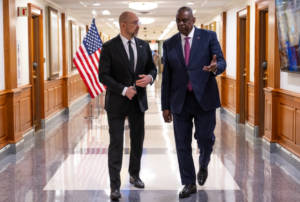Denmark and the Netherlands will lead the international effort to train Ukrainian pilots on F-16 fighter jets, Defense Secretary Lloyd Austin said Thursday.
Austin provided the additional details on the recently announced F-16 training effort following the latest meeting of the Ukraine Defense Contact Group, noting the U.S., Norway, Belgium, Portugal and Poland will also contribute to the initiative.

“Planning and executing this training will be a significant undertaking, but the coordination of this contact group will help make that possible. And I especially want to thank Denmark and the Netherlands which have decided to lead a European coalition in providing F-16 training for Ukrainian forces. In the coming weeks, my Dutch and Danish counterparts will work with the United States and other allies to develop a training framework,” Austin said at a press briefing. “And we expect more countries to join this important initiative soon.”
President Biden informed G-7 leaders at the group’s summit in Japan last week that the U.S. would support the months-long international effort to train Ukrainians on F-16s in Europe, likely to begin in the coming weeks (Defense Daily, May 19).
The move is a significant development in Ukraine’s ongoing request for combat aircraft to assist in its fight against Russia, while the Biden administration to date has not committed to providing platforms such as Lockheed Martin [LMT]-built F-16s as part of security assistance efforts.
Austin noted the high cost that will be associated with training and working toward providing Ukrainians with F-16s, suggesting a fund could be established for countries to contribute in support of the effort.
“It’s no surprise to anybody that this will be expensive,” Austin said. “The conversation that I’ve had with my counterparts, as we begin to frame out requirements for training and maintenance and sustainment, is that this costs money. And not every country has F-16s or is able to chime in in terms of training or maintenance or sustainment but they can provide monetary assistance. So what I think you’ll see our colleagues look to do is establish a fund so that other countries can contribute to this overall effort.”
Army Gen. Mark Milley, chairman of the Joint Chiefs of Staff, echoed remarks on the costs for this undertaking and how it relates to the U.S. and international partners’ focus to this point on providing ground-based air defense systems for Ukraine’s efforts to control its airspace during the conflict.
“If you look at F-16s, 10 F-16s are a billion dollars. You add sustainment costs, it’s another billion dollars. So you’re talking about $2 billion for 10 aircraft. The Russians have a thousand fourth and fifth-generation fighters. So if you’re going to contest Russia in the air, you’re going to need a substantial amount of fourth and fifth-generation fighters. So if you look at the cost curve and do the analysis, the smartest thing to have done is exactly what we did do which is provide a significant amount of integrated air defense to cover the battlespace and deny the Russians the airspace,” Milley said.
“As we go forward, F-16s clearly have a role. Ukraine deserves a capable air force. This is going to take a considerable length of time to build up an air force that’s the size and scope and scale that’ll be necessary,” he added.
Milley also responded to a question on the similar approach the Pentagon took on F-16s with Abrams tanks, where the department was initially not for including the platform in efforts to assist Ukraine before eventually doing so.
“It’s not a question of do we agree later or agree now or under pressure, that’s not at all what’s getting done here. This is hardcore military analysis that looks at cost, benefit and risk and what is the need on the battlefield now and the near-future. F-16s are much a longer view,” Milley said.
Austin said he’s been in discussion with defense leaders in Denmark and the Netherlands on what would be required to support Ukraine’s F-16 request.
“They recognize also that training is one thing but to have a capability you need sustainment, maintenance, you need ordnance. So all of that will be worked through with the committee going forward there,” Austin said.
A bipartisan group of U.S. senators sent a letter to Austin on May 14 seeking information on the factors around potentially providing F-16 fighter jets to assist Ukraine, citing the platform as a potential “game changer on the battlefield” (Defense Daily, May 18).